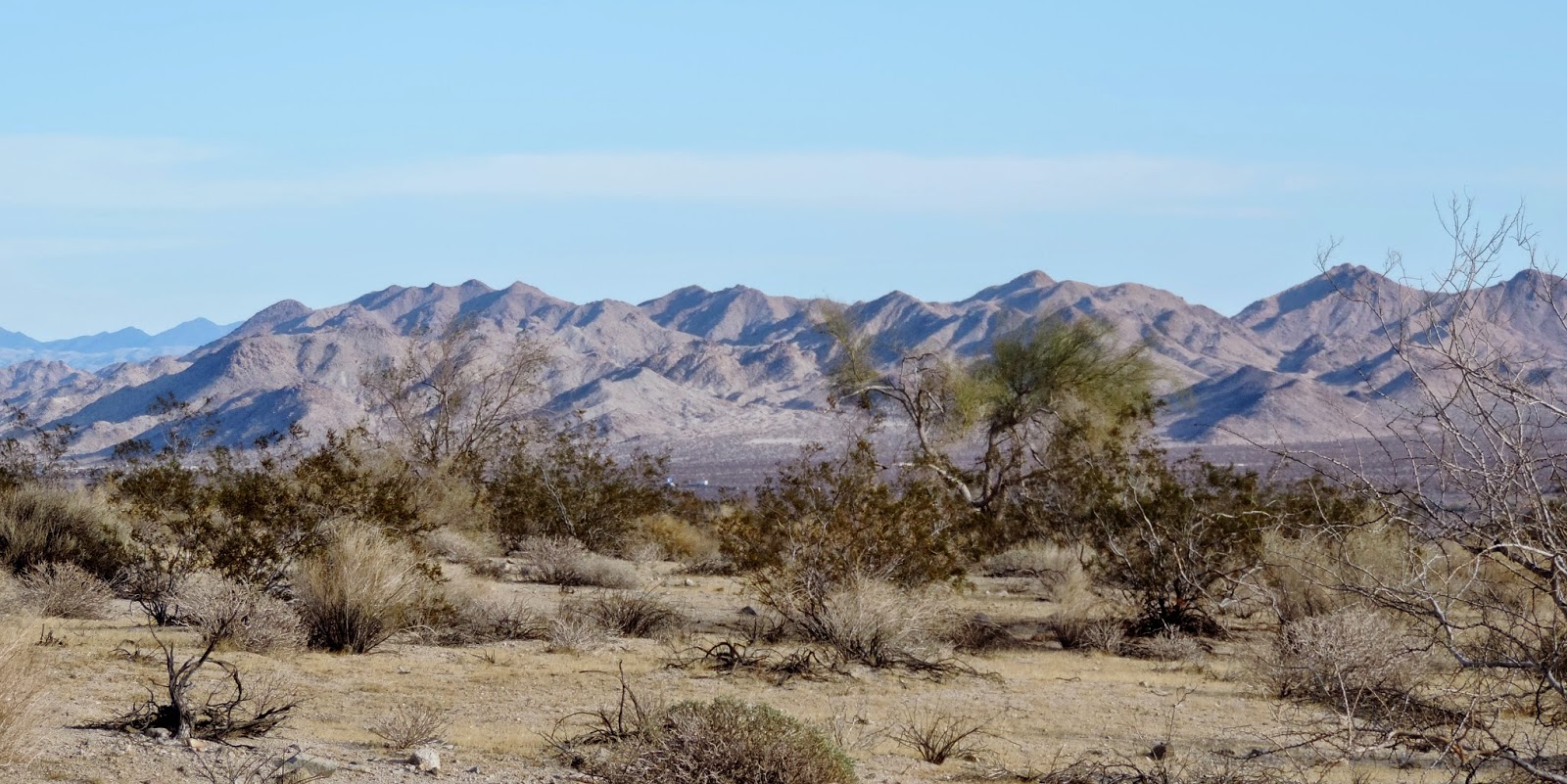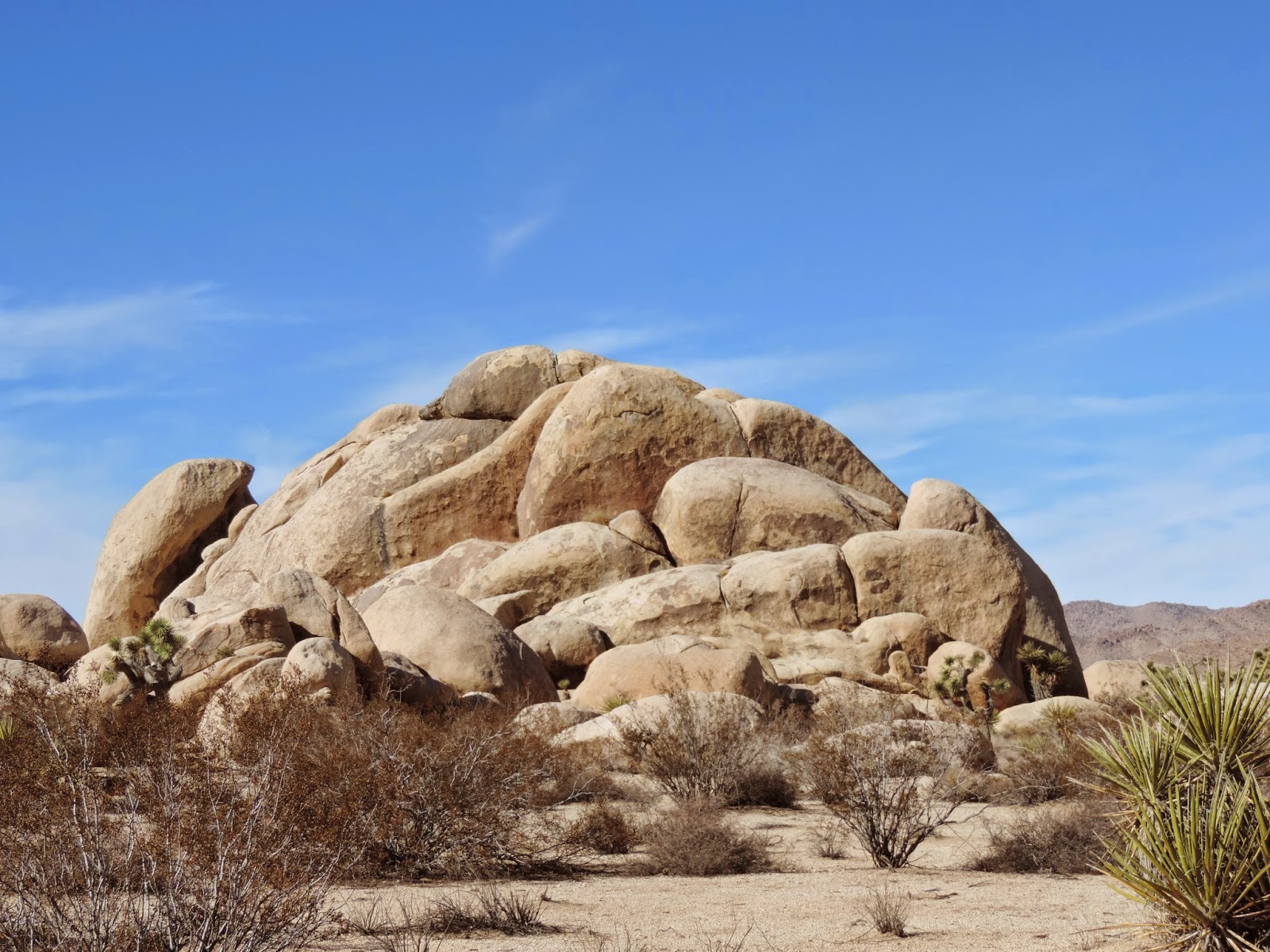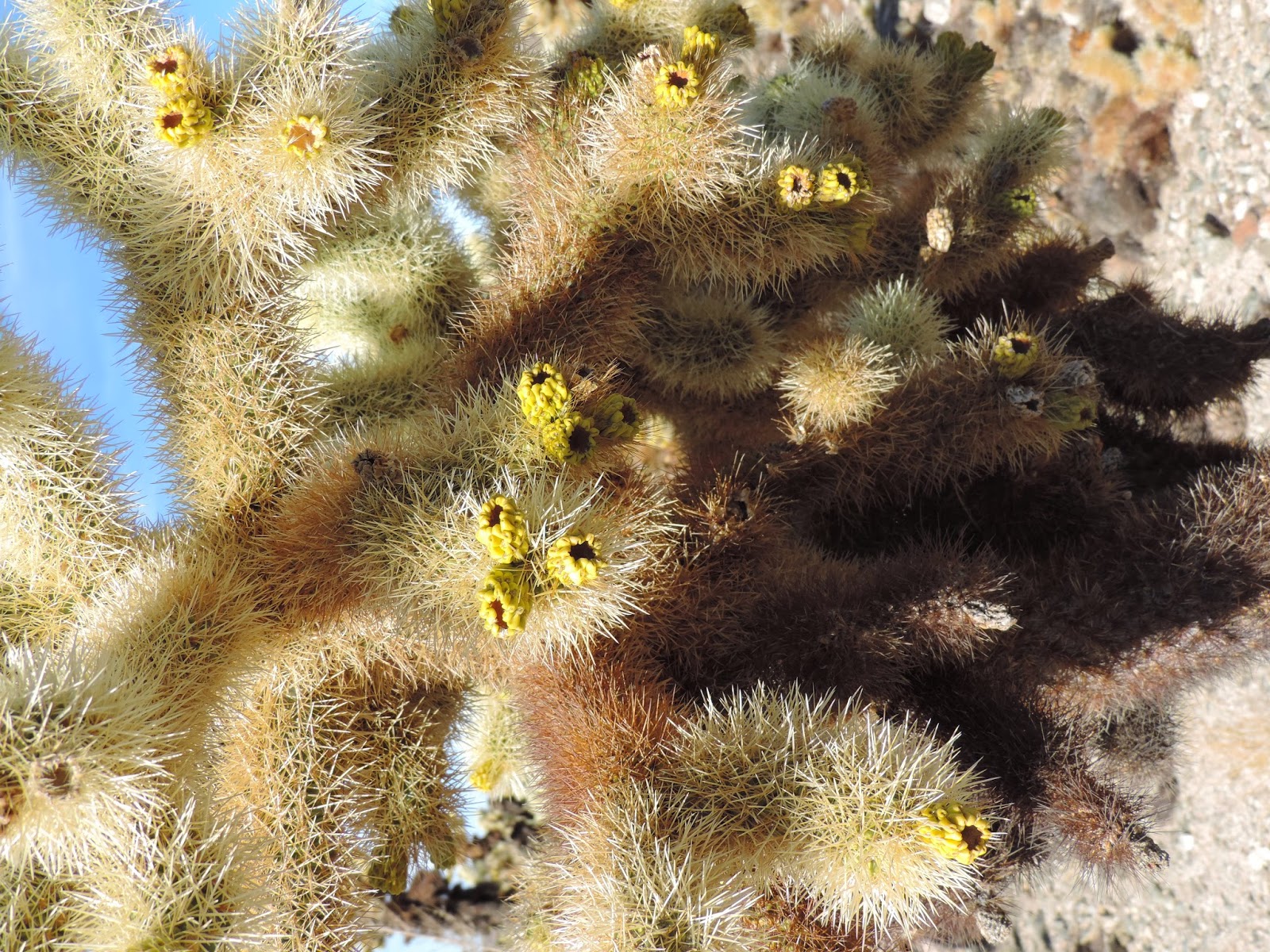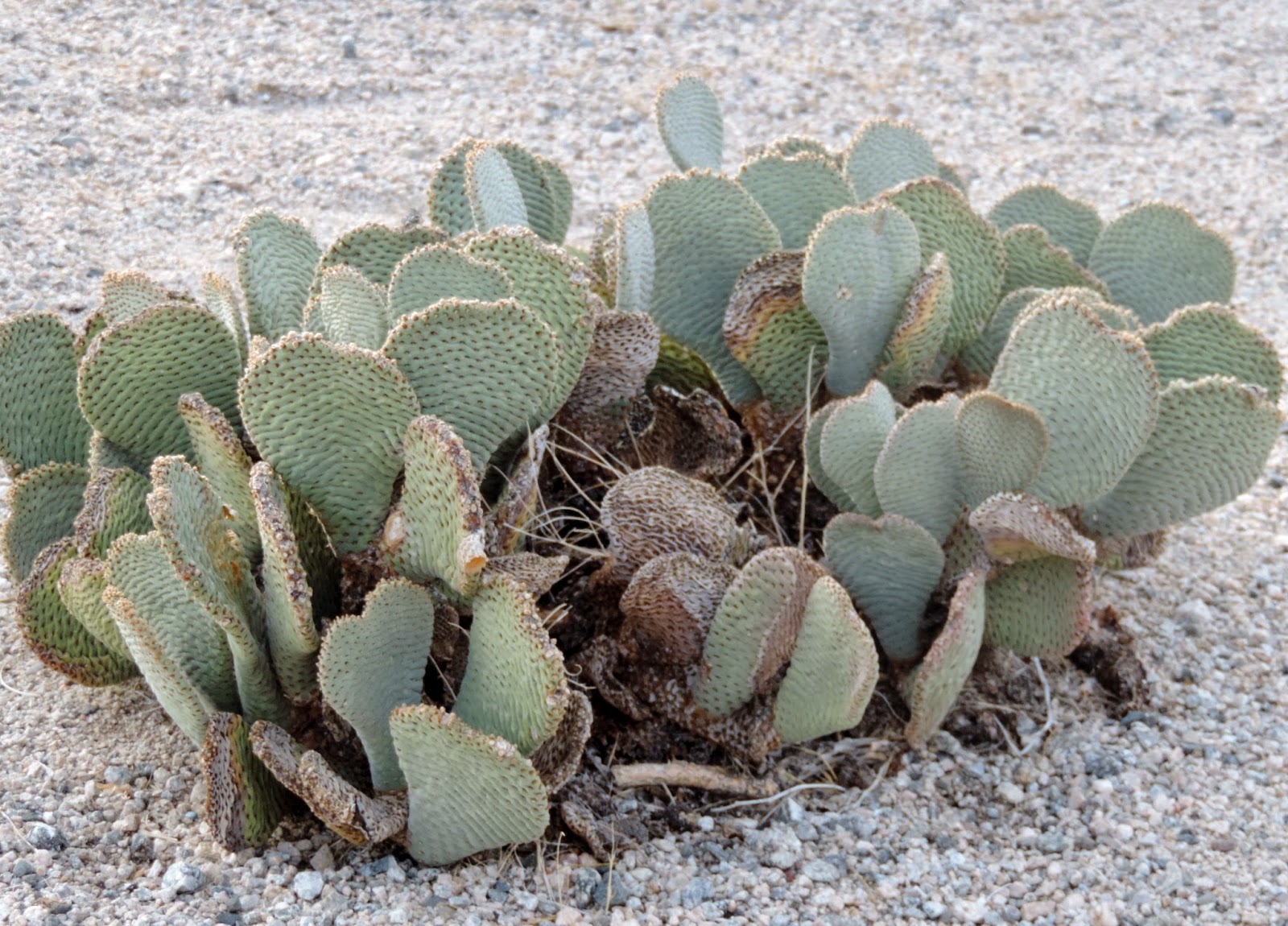The RV resort is located about 5 miles from the west Park Entrance, so naturally between my love for National Parks in tandem to our close proximity it was a foregone conclusion that we would visit the Park. We went into the park twice (so far) and here we are, Day 1, at the west Park entrance. This is not the most splendiferous National Park we have visited, but the desert has its own stark, natural beauty not found anywhere else.
It was a beautiful day in the low 70s--perfect desert weather! Today we took Pinto Basin Road through the park toward the Cottonwood Mountains and the north Park entrance, and then back again. Joshua Tree NP is actually a combination of two deserts which overlap within the park--the Mojave and Colorado Deserts. Both of the deserts are significantly different with the Mojave Desert being the more beautiful, less arid, and the desert where the Joshua trees dwell in abundance.
The Pinto Basin Road traverses the Park on the Colorado Desert side and "transition zone" of the two deserts. The Colorado Desert is a low desert, hotter and dryer than the nearby Mojave. This desert is a sub-region of the vast Sonoran Desert. It is a sand and rock desert of broad plains interrupted by mountains of igneous rocks. The plants you see near the end of this blog from the Bajada Nature Trail are representative of the Colorado Desert.
After a stop at the ranger station to get the lay of the land we headed out. Our first stop at White Tank featured these fabulous rock outcroppings.
Every rock outcropping we have visited out west has its very own "balanced rock"! Joshua Tree NP has a number of balanced rocks throughout the park just because the rocky landscape creates them in abundance.
Some interesting "stuff" hanging around in the desert habitat. I'm not sure what this plant/cactus is called, but it was all over the desert floor. I actually think it may be cholla cactus, but not the "jumping" cholla .... thank you, Jesus! We had a very bad experience with our dogs in Anza-Borrego and the jumping cactus there. It was not pretty.
This is a Loggerhead Shrike, one of the many desert birds.
I love cairns and here are two someone arbitrarily set up.
Our second stop was the Cholla Cactus Garden located in the Pinto Basin that lies within the ecological transition zone between the Mojave and Colorado deserts. Loose gravel and sand brought down from the mountains form alluvial fans and bajadas at their base; these loosely-packed, well-drained slopes are ideal for prolific cacti growth--especially the Teddy Bear Cholla.All cholla have woody skeletons and jointed branches. Their stem segments are not truly cylindrical, but rather a series of connected, raised tubercles from which spine-bearing areoles emanate. The spines of most cholla are covered with a papery sheath that reflects sunlight and protects the stems from overheating. This feature is especially pronounced in the Teddy Bear Cholla.
Teddy Bear Cholla appear covered with soft beige bristles, which account for its common, innocuous name. However these bristles are hardened spines, each tipped with a microscopic barb. These imperceptible barbs earn it its second nickname, 'Jumping Cholla', because entire joints can detach and imbed a transgressor with even the slightest touch (we can attest to that fact). Cholla barbs often require pliers for removal (we can also attest to that fact!).
The Cholla Cactus Garden Trail circles through a dense forest of Teddy Bear Cholla, Silver Cholla and Cresote.
Don't touch!!!
Our next stop was Ocotillo Patch. The Ocotillo is a bajada resident that can be relied on to bloom annually, even without leafing in particularly dry springs. It is an inverted, funnel-shaped desert plant with several woody, spiny, whip-like, straight branches angling outward from the base and rising as high as 20 feet.
Ocotillo are leafless most of the year, except immediately after rain; the leaves then quickly wither after the soil dries out. These narrow, oval leaves are about 2 inches long, appearing in bunches above spines. Unfortunately, the Ocotillo were not in bloom and looked "shabby". I've seen them in bloom and they are beautiful so I'm going to show you a photo of a blooming Ocotillo from the Internet ... just so you know they really are beautiful in bloom!
Before we get to the pictures, you may be wondering (like I was) what in the heck is a "bajada"? A bajada consists of a series of coalescing alluvial fans along a mountain front. These fan-shaped deposits form from the deposition of sediment within a stream onto flat land at the base of a mountain.
Lest you think they are harmless ... check out these barbs!
I had Gary stand by this Ocotillo so you could see just how tall they get.
And, here's a blooming Ocotillo ... isn't it beautiful?
Near the park exit at the Cottonwood end of the road was this nature trail, Bajada Nature Trail. So now you're going to get a desert botanical lesson. By now I'm sure you're ecstatic at the very prospect of it :). Unfortunately, the time of year leaves everything brown and dead looking rather than desert lush and green.This is a brittlebrush plant which is noted for being a good indicator of water conditions. The leaves are large and green during wetter times. When temperatures climb and soil moisture drops, the leaves become gray and brittle (like they are below and as you know we're in a drought). Brittlebrush provides a winter food source for bighorn sheep (which are supposed to be in this area, but we never saw one).
This is a Creosote bush. It is the most common plant in the hot, dry deserts. Many animals live in and around the Creosote despite repellant oils and resins that discourage browsing. Rodent burrows among the roots aerate the soil which helps water drainage.
This frost-sensitive Ironwood, a Sonoran desert plant, is found solely on this bajada. Only here does it find warmth and moisture to meet its specialized needs. The Ironwood, which can grow quite large, provides shelter for many shade-loving plants and animals.
Although the Palo Verde (Spanish for green wood or stick) has leaves only in wetter times, cells in the green bark can also carry out photosynthesis, or food production. The seeds are food for a beetle larvae. In turn, a wasp feeds on the larvae before all the seeds are eaten, thus ensuring future Palo Verde trees.
The Mesquite Mistletoe found on desert plants such as Polo Verde and Ironwood is a parasite. It draws food and water from its host. The berries are a major winter food source for the phainopepla, a black-crested bird, who in turn spreads the seeds to other trees where a new plant can take root. I don't want to go too far with this, but think about mistletoe being that which you are supposed to kiss underneath during the Christmas season ... and it's a parasite ... nuff said!
Once established, desert perennials persist and new plants must wait for a vacancy in the community. In the arid climate, deadwood could last for centuries. Termites help to breakdown dead plants and return nutrients to the soil. New seedlings can then get a foothold, continuing the cycle of life in this bajada community.
Beavertail cactus is a succulent, low-spreading, spineless perennial with flat, obovate to roundish pads 5"-10" long, and often transversely wrinkled. The areoles contain numerous short brown barbed bristles which can be painful if one brushes against them. This cactus blooms from March to June with flowers that are rose to magenta in color.
We were almost back to the park entrance when I had this epiphany ... I had not taken one picture of a Joshua Tree in Joshua Tree National Park! Oh no! Can't let that happen, can we? The Joshua Tree is called the Tree of Life in this desert. It is to the Mojave Desert as the Saguaro Cactus is to the Sonoran Desert--both plants are host to many animals dependent upon them. The blossoms of the Joshua Tree are pollinated only by the Yucca moth.
It was getting to be sunset and the clouds made a beautiful backdrop for my final park pictures of the magnificent Joshua trees.
Joshua 3:7
Now the LORD said to Joshua, "This day I will begin to exalt you in the sight of all Israel, that they may know that just as I have been with Moses, I will be with you."


































No comments:
Post a Comment